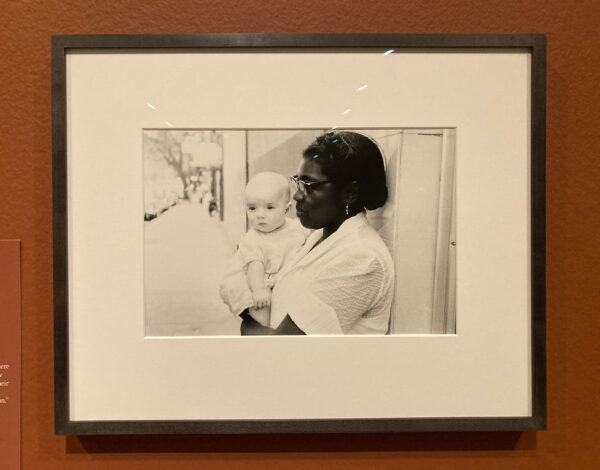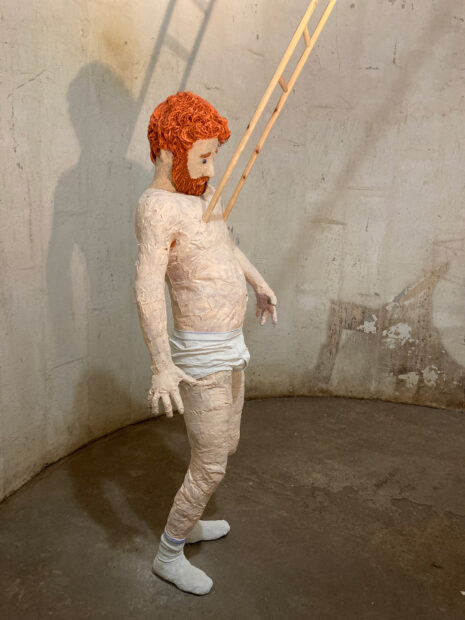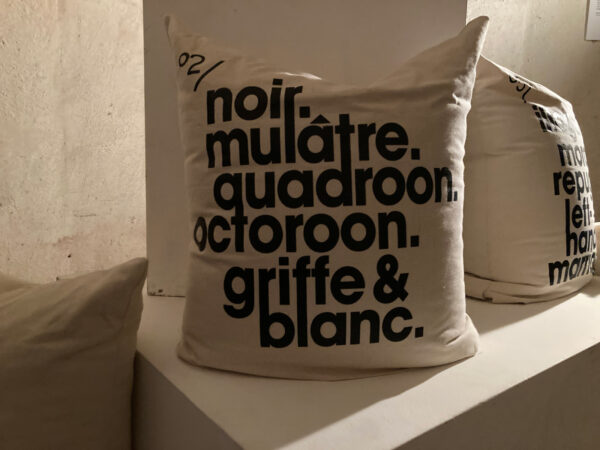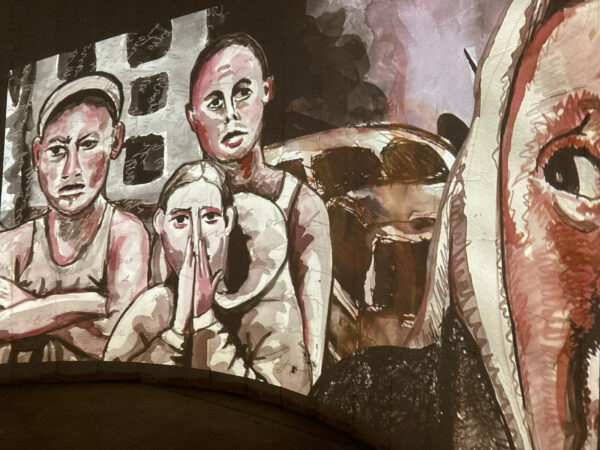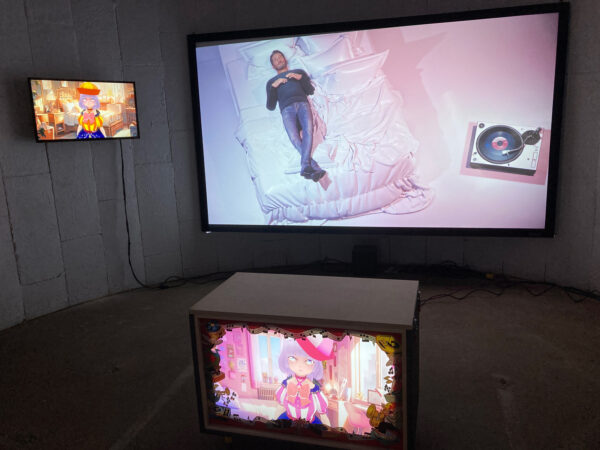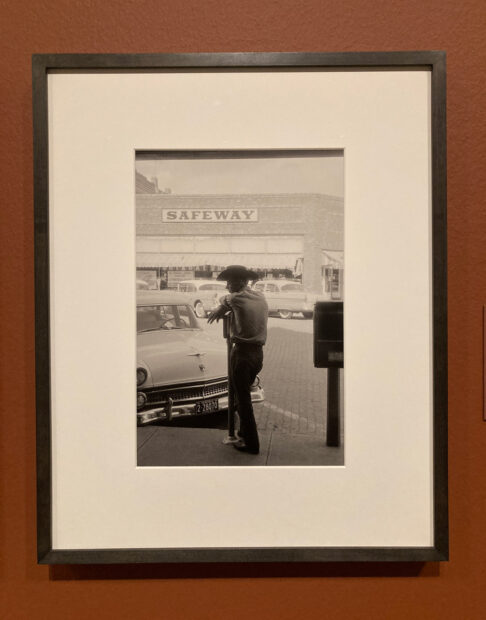
Todd Webb, “Cowboy,” Lexington, Nebraska, 1955, printed 2023, inkjet print, The Todd Webb Archive, Portland, ME.
Robert Frank and Todd Webb: Across America, 1955 at the Museum of Fine Arts Houston, October 8, 2023 – January 7, 2024
Robert Frank and Todd Webb’s photographic journeys across America in 1955 provide a fascinating exploration of the United States during a pivotal era. The two photographers used different methods and perspectives to capture the diverse aspects of American life.
Frank’s approach was dynamic, often taking photographs from the window of his 1950 Ford coupe. His selective focus and bold, confrontational style allowed him to critique the social divisions and economic inequalities in America while maintaining a compassionate portrayal of its people. His work, particularly his iconic photo book The Americans, played a significant role in documenting more down-to-earth and real human attitudes and struggles amidst the larger political movements of the time.
In contrast, Webb took a more measured and deliberate approach to the images he captured. Walking, boating, and hiking his way across the country, Webb’s pedestrian pace allowed him to provide a precise and detailed look at the American landscape. With a sense of humor, he revealed the nation’s obsessions with new products and social status, highlighting the empty promises of American consumerism.
Common themes emerge in both artists’ works, which depict a young country eager to project its message. In these photographs, we see those in power juxtaposed with American subjects who must comply with the social order. Frank and Webb managed to document the human attitudes that existed not only within but between the larger political narratives of the era.
One notable difference between the two photographers is their age and experience. Frank, younger and fresher, had already gained recognition with exhibitions at MoMA and photographic work for legacy publications like Fortune Magazine. The Americans even featured an introduction by Jack Kerouac.
Since Frank and Webb intentionally worked against the illustrative expectations of publications like TIME Magazine, their photos certainly reflect their resistance to convention, stability, and rigidity. They capture a lost America that’s transitioning to the modern era, with themes of mechanization of labor, the challenges of integration, and the prevalence of automobiles. Frank’s passion for portraying those often overlooked by mainstream media, especially those economically disadvantaged or impoverished, is evident in his work.
Webb’s photographs also provide unique insights into American society, from a yacht club whose members had no yachts, to cowboys in New York City who had no horses. While it might be brash to declare Frank and Webb as the exclusive authors of the “real” America, their work undeniably offers a deeper and more nuanced look at American subjects who existed in spaces in between the conventional narratives of their time.
****
Sculpture Month Houston presents The Sleep of Reason: The Fragmented Figure at the Silos at Sawyer Yards, October 7 – December 2, 2023
In Ladder Nipples, artist Jeff Gibbons explores the symbolism of ladders, which triggers various associations and stereotypes. Ladders often denote overcoming obstacles, as a nod towards aspiration. They also represent the idea of climbing up the social or corporate ladder to achieve success. Gibbons has employed a scruffy papier-mâché effect for this life-sized work. His ability to render characters remains brilliantly intact here.
Rabea Ballin presents History slept on #sixwordstories, a collection of short-short stories inspired by Ernest Hemingway’s famous six-word story challenge. These stories delve into the history of New Orleans, where the French Code Noir of 1724 prohibited miscegeny (the mixing of races) in the French Colonial Empire. To circumvent this prohibition, the practice of plaçage was established, leading to intermarriage that eroded perceptible racial differences. The stories shed light on the lives of free women of color, and the ways in which their agency is made possible through exceptions to the norm.
Jimmy James Canales’ Zuzan is the culmination of the artist’s exploration of the human figure and its representation. It reflects his continuous inquiry that began during an art residency in Berlin in 2019. In 2022 he presented The Line Layer at the Contemporary at Blue Star in San Antonio, where he created a personal universe with robotic avatars named Chromito, Mapachito, the Collector, and Concepciònatron. Canales’ work blurs the line between human and machine, with a modular quality in his maquettes that feature appendages with shelves and panels. His work poses the intriguing question: What is a robot? This question evolves with each generation, challenging our understanding of technology and the human form.
Yuliya Lanina’s mother and father come from Ukraine and Russia, respectively. In the wall text for her piece at the Silos, she says her animation is a simulation of what it’s like to watch the current war between the two nations, almost as a parental conflict, on a loop in broadcast media. Red and black watercolor and ink illustrations are mostly still, and scroll by on the silo’s curved walls. Faces of horror stare back at the viewer, in opposition to the works in the MFAH’s Robert Frank and Todd Webb: Across America, 1955, where some of the subjects are facing away, in order to get the most candid essence.
A male figure in a bedroom listens to a vinyl record while two anime figures lip sync to “Mr. Sandman” by The Chordettes. This is one of the more interesting uses of the cylindrical silos, as three screens are installed on the interior wall, with a fourth monitor sitting on the floor. I think Kris Pierce’s video work has the capacity to be didactic, almost as a performance lecture. His use of video as a medium continues to blur the lines of what is possible in sculpture and painting. The character in the work is describing the dynamics of humans not only forming bonds online, but also creating bonds with the simulacrum itself. It’s hard to hear, the low frequency sounds reverberate, and there’s a lot of crowd noise. However, Pierce is an artist working in emergent themes that few are able to elucidate. His vision remains beautiful and crisp.
****
Matty Davis and Ben Gould: Carriage, Bearance and Severance at the Dallas Contemporary, October 20, 2023, 7-8 p.m.
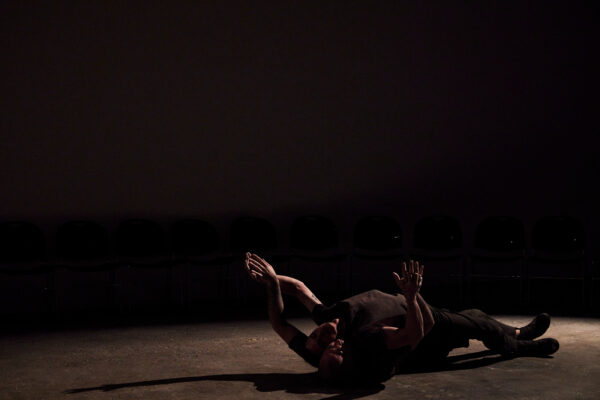
Matty Davis and Ben Gould perform “Carriage, Bearance, Severance.” Photo: Steven Visneau, courtesy of Dallas Contemporary.
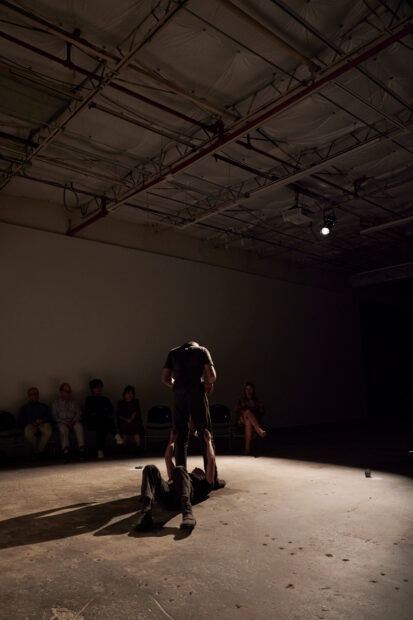
Matty Davis and Ben Gould perform “Carriage, Bearance, Severance.” Photo: Steven Visneau, courtesy of Dallas Contemporary.
Matty Davis and Ben Gould’s performance artwork Carriage, Bearance, Severance is an exploration of unity, interaction, and the complex dynamics between two bodies. In this hour-long piece, the two artists engage in a physically demanding and emotionally charged relay of tension and release.
The performance begins with both artists wearing brown attire; their movements are accompanied by the sparking of metal-tipped shoes against the concrete floor. As they writhe on the ground, an evident sense of dynamic reliance and opposition to one another comes through different actions. They each take turns hanging onto the clavicle of the other, which seems either painful or at least exerting an immense amount of pressure on a sensitive area. This type of action is constant throughout the performance: being so close that the weight of one conditions the behavior of the duo.
In an interview before the performance, the artists discussed the development of the work, shedding light on the personal motivations behind it. “When we first started working together, I developed Tourette’s Syndrome all of the sudden. I was grappling with how to deal with that in my own body, and pretty quickly Matty helped me learn a lot about that through our work together,” said Gould. With that insight, the performance does appear to have a collaborative effect greater than choreographing a dance. There is a great deal of bodily awareness shared between the duo that involves technique and practice, but perhaps more importantly, intuition.
The performance is divided into three parts: “Carriage,” “Bearance,” and “Severance.” “Carriage” involves lifting and supporting one another, emphasizing mirroring and release, while “Bearance” explores the weight and physicality of their interactions. The artists often express stress vocally, and the process is a continuous exchange of energy. “Severance” is the final part, where the pair eventually separate, and later reconvene and touch foreheads, conveying acceptance. The lung capacity of the two seemed to be tested throughout the performance.
Carriage, Bearance, Severance challenges the conventional understanding of relationships and human interactions, leaving viewers with a profound sense of unity, balance, and acceptance. It’s an exploration of performance art that tests its own limits.
William Sarradet is the Assistant Editor for Glasstire.


